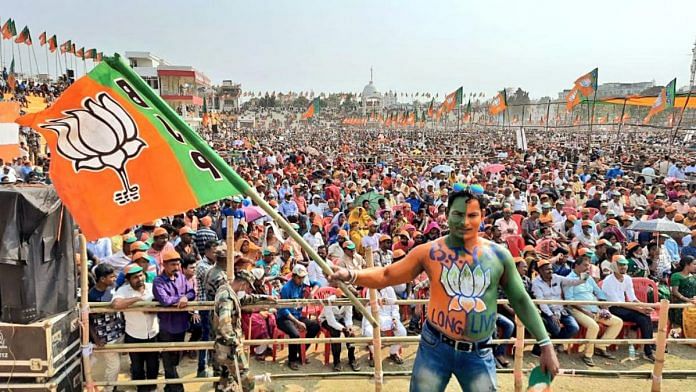
Thank you dear subscribers, we are overwhelmed with your response.
Your Turn is a unique section from ThePrint featuring points of view from its subscribers. If you are a subscriber, have a point of view, please send it to us. If not, do subscribe here: https://theprint.in/
17th December, 2018, after an exile of 15 long years, Bhupesh Baghel took oath as the 3rd CM of Chhattisgarh and the Indian National Congress stormed to power with 68 seats. Many believed that the more experienced T.S. Singh Deo being denied his due could lead to future power struggles, however, CM Baghel not only deftly handled internal INC conflict but over the next few years also kept the BJP from mounting a comeback while consolidating his own position as a strongman leader.
BJP’s demography related weaknesses
Chhattisgarh, where the forward castes vote makes up less than 10% of the electorate, leaves the political arena ripe for INC to maintain a healthy vote share from among the SC, ST and even OBC communities. The nationwide trend of forward castes moving to the BJP did not present a significant challenge for the INC in Chhattisgarh as they swept 25 out of 29 ST and 7 out of 9 SC reserved seats across the state. Four years have passed since these results, and the BJP has yet to organically cultivate leaders from the SC and ST communities. Furthermore, BJP’s Hindutva narrative does not sit well with many tribals in the state who have conflicting views about their own rituals and customs. Their representation within the party’s rank and file is lacking and the cadre diminishes in diversity and strength. In contrast, in Uttar Pradesh, the BJP was successful in forging a non-Jatav SC coalition by not only offering tickets to community leaders, but also by including subaltern representation in their local machinery, such as booth committees, thus forming a connect at the grassroots level. The Sahu community forms the bulk of the OBC group and has traditionally supported BJP, due to their entrenchment in the power structure over the last 15 years, INC tapped into the simmering resentment among non-Sahu OBCs and managed to consolidate vote against the Sahu community in many constituencies. This phenomenon has put the BJP into a conundrum of consolidating Sahu voters or wooing non-Sahu OBC communities.
CM Bhupesh Baghel’s popularity and astute policy interventions
Taking a page out of PM Modi’s playbook, CM Bhupesh Baghel has focused on enhancing his personal brand across the state while showcasing state schemes and policy interventions as “under his guidance” which has seen him form a strong connect across the state thus being able to keep detractors at bay and consolidate his position as a one man show in Chhattisgarh.
The CM has showcased his sharp political awareness by staying one step ahead of the BJP with regards to issues that may be considered more natural to BJP’s arsenal. In 2020, CM Baghel launched the Chhattisgarh Godhan Nyay Yojana (CGNY) aimed at protecting cattle, formulating an ecosystem around cow dung utilities and importantly disarming a long used political weapon of the BJP. Under CGNY the state government constructed thousands of Gothans (cow sheds) across the state to safeguard cows and form the nucleus of an ecosystem consisting of state purchase of cow dung at Rs.2/- per kg and leveraging women’s cooperatives to convert cow dung into fertilizers and then selling it to farmers at cheap rates.
Another religious initiative undertaken by CM Baghel is the formulation of the “Ram Van Gaman Path”, the path Lord Rama, Sita and Lakshmana took during their exile, this involves developing key areas of the state which fall within this path.
A key poll promise of the INC was direct procurement of Paddy and Maize from farmers, a state where 70% of the population is directly or indirectly dependent on farming, this became a rallying point for disgruntled farmers. In 2020, CM Baghel launched the Rajiv Gandhi Kisan Nyay Yojana (RGKNY) under which Rs.5750 Cr was distributed in quarterly payments across the year. Specifically, farmers growing rice were provided a support of Rs.10,000/- per acre. Furthermore, in 2021 the state government started procurement at Rs.2,500/- per quintal. These direct benefit transfers has seen a large section of the farmer community convinced that the incumbent government deserves another term in power.
BJP’s internal weaknesses
In Chhattisgarh, BJP suffers from heavy factionalism and lacks clear leadership. While former CM Dr Raman Singh remains the tallest leaders in the BJP ranks, the high command seems to be pushing him to a central role to allow younger leaders to step in, however, this period of indecision has hurt the BJP as no specific leaders have been promoted officially. The leaders of the past 15 years move towards the end of their political tenures and no one specific BJP leader has the charisma or popular base to compete with CM Bhupesh Baghel leaving them with the only option of falling back to contesting on PM Modi’s popularity and perception.
These pieces are being published as they have been received – they have not been edited/fact-checked by ThePrint.

COMMENTS